Managing Tarmac Tennis Courts
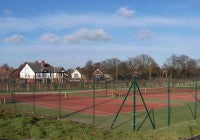
The answer is to ensure that certain key operations are regularly undertaken after installation, in order to promote the best level of playability as well as maintaining the quality of the surface for as long as possible. Nevertheless, replacement is inevitable and, at this time, guidance is often needed on what options to take. However, the life span for these surfaces can be dramatically improved if the correct management programme is in place.
Construction types
A typical construction profile would show: a firm gravel or scalping sub-base, a coarse binding layer of tarmacadam and a finer grade of porous tarmac as the top layer. Hopefully, the sub-base layer is coupled with a drainage system.
These characteristics should ensure good drainage in wet conditions. There are many variations of the design, but this profile is typical for courts over five years old. Modern versions are slightly more complicated and the increase in complexity is reflected in greater longevity and subtle improvements in playability.
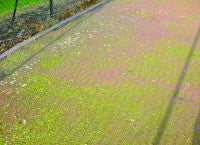
Court evolution over time
As these courts age, the pore spaces within them begin to clog with debris. Of course, the rate of contamination within the top layer will depend on the local environment and the amount of fines finding their way on to the surface.
Mosses are also a very influential problem with regard to court management, although a restricted environment is not necessarily needed to promote moss development. Mosses can be difficult to successfully kill and remove. Moss spores are always present and can quickly regenerate after cleansing if the right removal and preventative measures are not taken. Picture right Moss on court
Mosses invariably out-compete other vegetation where growing conditions are dank and shady with poor nutrient qualities. I often see problems with water draining onto the playing surface from surrounding areas. Alternatively, because of poor levels within the court, water is directed into one or two main areas which become clogged at a faster rate, often encouraging moss development problems.
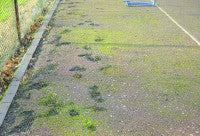
The importance of site investigations
The STRI can undertake a site investigation on tarmac or polymer-based courts, and give advice on the best way to manage their maintenance needs. There are many aspects that must be identified and considered to help determine the best way forward with maintenance. We need to look at general court condition, safety aspects, the influence of the surrounding area, drainage rates, analysis of current maintenance practices and site security. Once the information is considered, a full maintenance programme can be produced.
Maintenance considerations
A successful maintenance programme will include:

- Routine debris removal
- Appropriate measures (if possible) to reduce contaminants finding their way on to the court
- Improvement of light and air qualities surrounding the court
- Annual renovation cleaning (appropriate pressure washing)
- Chemical control and prevention of live contaminates (mosses, grass and broad-leaved weed matter, tree roots and suckers)
- Provision for colour coat and line marking replacement
- Upkeep of the court furniture, to include fencing and nets
Pressure washing
Pressure washing to remove the moss and algae that forms throughout the year is the most common maintenance operation. It is not a case of using a basic pressure washer as you would to clean your car. The depth of the contamination and large surface area can make it hard to wash even a single court correctly.

here are more sophisticated, successful ways to pressure wash. Some contractors offer multi-head washing units that cover ground quickly and, set in the right sequence, remove most of the contaminates. Steam cleaners are not advised. Picture right depression on court
Light, frequent maintenance
Brushing is regularly practised by many, but may not be as effective as you may think in the long-term. Brushing will break apart debris such as leaves and soil causing it to infiltrate the permeable surface. Over time, this action can drastically reduce drainage and infiltration rates, leading to more severe and frequent secondary problems with moss and algae.
Blowing the debris off the surface is preferred, and will prevent depositing debris deep into the pores of the tarmac. Prevention is always better than cure and so anything that can be done to minimise debris movement onto the surface is worth investing time in, e.g. pruning planted areas and trees, covering loose soil areas as well as weaving solid fence material into the lower chain fences to stop dust blowing onto the surface.
Chemical usage
Using chemical agents for moss, algae and plant material control is not as straightforward as one might think. There are only a handful of approved chemicals that can be used on artificial surfaces. Choosing, applying and working with pesticides within government legislation must be managed successfully. Damage to the surface, surrounding environment, users and/or legal problems may result if proper practice is not followed.
he pesticide product must be classified for use by the Pesticides Safety Directorate (PSD) for use on "Hard Surfaces" that are defined as "manmade impermeable surfaces that are not intended to bear vegetation". Consultation should also take place with the installers of the surface to find out which products they allow for usage (especially important if within a warranty period).
Court cleaning products approved for use on tarmac tennis surfaces are as follows:
- Mosskillers
- Degreasers
- Broad-leaved herbicides
The majority of maintenance contractors will combine control and prevention products to remove moss/algal growth, stop it from returning for as long as possible as well as ensuring the materials that make up the court are not damaged. Some of the issues that can arise from using the wrong chemical agents include: staining, paint splitting or removal, failure to control problem moss/algae etc., loss of surface traction leading to safety risks, and unlawful use of non-approved agents.
Degreasers
Degreasers are useful for courts that receive traffic pollution from nearby roads or industrial sites. This problem should be identified early on in court development and guarded against. Players will notice when the surface becomes slippery. Similar problems can be experienced with tree sap that drops from overhanging branches.
Plant matter control
Herbicides for pre-emergent or post-emergent control must be selected with care. The guidelines mentioned previously will help select the right product to control the right weed at the right time. Residual herbicides may offer longer-term control by sticking a coating of the active ingredient to the tarmac surface and within the pores. Sometimes, depending on the product, control can be in excess of two months, which is good considering the permeability of the material. Any chemical agents used on the surface must only be handled and applied by qualified people. Records should be kept with a detailed account of the application process to include: name of person/company, product used, weather data, target pest, etc.

Fertiliser elements
Although it is quite common to use elemental products such as sulphate of iron, etc. on natural turf surfaces, the practice should not be practised on artificial surfaces of any kind. The iron will stain line markings, degrade polymer compounds and probably not do a great job at controlling mosses. If fertilisers are applied to the surface by accident, blow them off as quickly as possible before they break down.
Hot weather usage
Take care to avoid damage to surfaces during hot weather. Tarmac, as we all know, becomes soft as the temperatures increase. Using heavy brushing or cleaning equipment can cause rutting in the surface. Even play under soft conditions runs the risk of creating problems. Any maintenance or usage of the surfaces must take into account the stability of the tarmac if problems are to be avoided. Hand watering the surface can help to re-stabilise it before play or maintenance.
Resurfacing and reconstruction
There will come a time when the surface of the court has worn to a point where improvements are needed. Erosion of the tarmac surface, invasion of tree roots or even settlement can lead to court damage. Two options exist: resurfacing and reconstruction. The first is where a new coloured coat is applied to the surface and each court is re-marked. The second is where the entire surface is replaced with new tarmac material and perhaps a polymer layer with a final paint and line marking process.
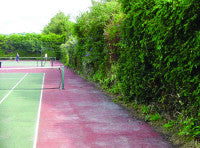
The main separations between the two options are cost and longevity. It will no doubt cost much more to replace the court than it would to simply re-colour it. However, the reconstruction option will sustain the court quality and playability much longer than the colouring option. Colouring may not be an option if the court surface is heavily damaged. We must also consider drainage capacity.
Reconstruction involves creating holes on a 50cm grid across the surface linking the surface with the porous drainage subsurface. There will almost certainly be poor porosity within the old tarmac layer and this option effectively bypasses it, returning full drainage performance once more.
A significant potential problem with re-colouring is the blocking action it has on porosity. There is a risk that the paint will seal the upper pores and could cause water to puddle thereafter.
Tarmac depths and sub-base material depths also influence the extent of reconstruction. A secondary layer of tarmac may be needed so that a stable base can be created that will withstand time.
The use of a regulated contractor working to LTA standards is critical to avoid quality problems. An approved list of contractors is available from the STRI or from SAPCA (Sport and Play Constructors Association).
Typical stages in court replacement:
- Pressure washing and debris removal
- Piercing of the existing tarmac surface layer at 50cm centres
- Placing tarmac in any depressions ahead of the main works
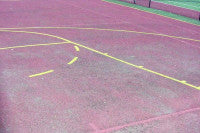
- Cleansing of the surface
- Application of a pre-emergent herbicide
- Curing period (four weeks)
- Cleansing the surface again (if required)
- Spraying of colour coat and line marking
- Curing period (four to five days)
Establishment period following a new construction
There is an expectation that the period following construction must be managed in a sensitive and sensible way with regard to usage and maintenance. "Bedding down" takes weeks or even months to occur. This is where the softness of the surface begins to subside after laying as the temperatures fluctuate, rainfall occurs and the courts become lightly used. It is not uncommon to see some water repellence in new surfaces as a result of the oils and surface tension within the new tarmac. As with most things, the weather patterns after laying will dictate the rate at which the surface cures.
Summary
With a good maintenance programme in place, the life of a tarmac-based tennis court can be in excess of ten years from the time of construction. How regular and detailed the maintenance programme will need to be depends on many peripheral factors.
A typical maintenance programme
| Task | Daily | Weekly | Monthly | Annually | In lifetime |
| Blowing | X | (X) | |||
| Brushing | AN | AN | |||
|
Weed and
moss control |
(X) | X | |||
| Surrounds management | X | (X) | |||
| Line marking | 4-5 Y | ||||
|
Furniture
maintenance |
X | (X) | |||
|
Replacement
of surface |
X | ||||
|
Key: AN = As needed. X = Preferred time. (X) = Minimum time |
|||||
